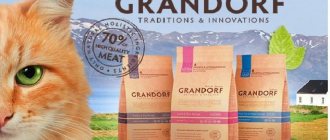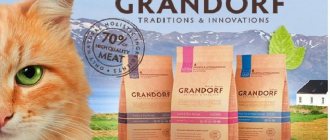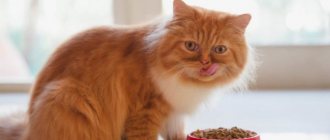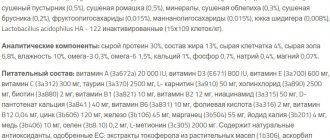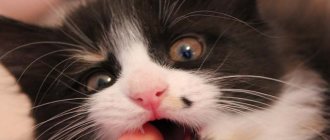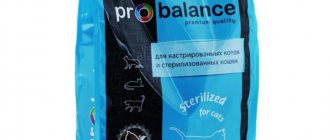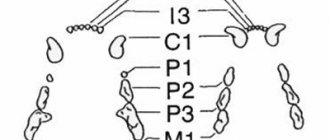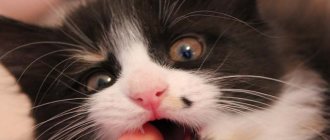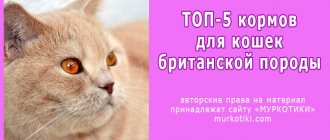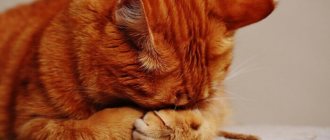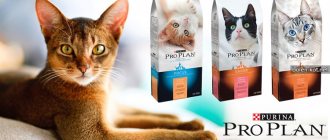Cats, like humans, have different nutritional and dietary needs at different stages of their lives. Kittens have seemingly limitless energy and must consume nutrients to keep up with it. As they mature, they will burn much less energy, but will need to maintain a healthy weight and eat a nutritious diet. As your cat ages, she will exercise less and consume fewer calories. But these are only very general dietary needs, and your cat has more specific vitamin and mineral needs depending on their age.
Read on to learn when to switch from kitten food to adult cat food.
When does a kitten become a cat?
Kittens are young, playful and still learning to play. During this time, they are very active for some time, but they also need to sleep for long periods of time. They will use their brains to learn new behaviors and learn new skills.
© shutterstock
Young kittens also form new relationships with their humans and other animals. When a kitten reaches about 6 months of age, it is considered an adolescent, so a kitten between 6 and 12 months of age is more like a teenage child. They will begin to develop most of their skills, they should have a good understanding of what is right and wrong, but they will still have a lot of pent up energy to burn off.
Once a kitten reaches 12 months of age, it is considered an adult cat, although giant breeds may not be fully developed until 18 months of age. For a normal-sized indoor cat, you will want to switch from kitten food to adult cat food at 12 months.
The need for complementary feeding for kittens up to 1 month
The benefit of breast milk lies not only in its fortified composition, but also in the transfer of protective antibodies. Together with him, the baby receives passive immunity, protecting against infections until the first vaccinations.
If natural feeding is not possible, then artificial milk formulas are introduced into the diet. You can buy them at a pet store or veterinary pharmacy.
NOTE!
The use of goat's and cow's milk is only permissible on a short-term basis. Their prolonged use causes intestinal problems and contributes to the development of vitamin deficiency.
What is included in kitten food?
Kitten food is intended for very young cats. It has a high fat density, which means it contains a lot of calories in a small amount of food. This calorie content is why adult cats gain a lot of excess weight if they eat kitten food. This is a common occurrence in multi-cat households where the adult cat eats the kitten's food and should be avoided.
In addition to being higher in calories, kitten food is typically rich in omega-3 fatty acids, calcium and phosphorus. These nutrients help in the development of everything from healthy coats and skin to strong bones and a healthy brain.
Do I need to add any of the following to dry food?
No, if you give your kitten a complete, balanced food, it already contains all the ingredients listed: animal proteins, fats, beneficial micro- and macroelements, probiotics, fiber.
Pay attention only to the composition of the product: all components must be clearly indicated (not just “meat”, but for example, “fresh turkey meat”). If it is impossible to calculate the percentages even approximately, it is better to choose a different diet for the kitten, with a more transparent composition. We believe that this information is very important for owners, so we indicate the percentages of each ingredient!
We do not recommend mixing ready-made food with natural food, even at different feedings: you will not be able to determine how many nutrients the kitten receives, and it is very easy to make a mistake with the dosages. In addition, such mixing is a direct path to food vagaries in the future.
Can kittens eat adult cat food?
It is not uncommon to hear the myth that kitten food is nothing more than a marketing ploy; the same food as adult cat food, but wrapped in kitten packaging and sold at a higher price.
It is not true. Kitten food does contain a variety of ingredients that will help your kitten develop properly and healthily. But can they eat adult food?
Some adult foods are suitable for kittens. Check the packaging and if it says it is suitable for all life stages, it means it makes a good kitten food. Considered nutritious for older cats, adults and kittens.
Otherwise, you should avoid feeding adult cats kitten food until they reach the appropriate age.
How much food to give kittens?
Probably everyone has heard the phrase “A kitten’s stomach is no bigger than a thimble.” This is not entirely true, because at the age when the baby enters the family, and it is advisable that this happens no earlier than 3 months, the volume of his stomach is about 40 ml and resembles a small pile. But this is still very little, so kittens need to be fed in small portions, but often. If the pet has eaten and stopped, most likely there is no “room” left, but as soon as the food is digested, the baby will be hungry again, and this will happen very quickly!
The fact is that the energy needs of cubs are very high, they are an order of magnitude higher than those of adult animals, so the diet of kittens should not be empty and dietary, but extremely saturated - contain a maximum of useful substances and “building material”. Only then will the kitten truly eat, grow and develop.
From birth to one year, a kitten increases its body weight by 40-50 times (for example: a human child - on average, 15-20 times). Up to 2 months, he needs about 220 kcal per kg of body weight, then the norm decreases and by the year reaches 45–50 kcal per kg of weight.
However, overfeeding is also not a completely correct practice. This is fraught with gastrointestinal disorders, as well as the appearance of excess weight, which puts stress on the growing joints of kittens and is especially dangerous for large breeds, such as Maine Coons. What to do?
- Acana food packages, as well as other wet and dry industrial food, must contain a table with feeding standards - follow them. Dosages of canned food are usually indicated in bags (pouches), and for dry food - in grams. It is advisable to use a scale or measuring cup.
- Weigh the kitten from time to time in order to adjust the portions in time (over the course of a week, its weight should increase by at least 50 g, and preferably by 100 g or even more for large breeds).
If there is no weight gain, it is likely that the kitten’s diet is low in nutrition or you are underfeeding it. Of course, this is only true if the animal is healthy and not infected with parasites. Analyze the kitten's menu and show it to the veterinarian.
How to choose food for adult cats
There is a huge range of food for adult cats on the market, including dry and wet food. You can even find freeze-dried raw food ingredients.
Wet food keeps your cat hydrated and provides essential nutrients. It can also be more appealing, but it is more expensive, will only stay fresh for a few hours once it's in the bowl, and has a shorter shelf life than dry food.
Dry foods last longer in the cupboard and in dishes. It is less expensive than wet food and can contain all the essential nutrients. Plus, it smells less and creates less mess around your food bowl.
© shutterstock
You can also combine dry and wet food. If you do this, make sure you only feed half the recommended amount of each per day, otherwise you will overfeed and your cat will become overweight.
Whatever food you feed your cat, remember that he is an obligate carnivore. He ate meat in the wild, and that's where most of his protein must come from. Buy animal protein based products.
Dry or wet food?
There are two types of wet food:
- pouches (“bags”) - contain quite a lot of moisture in the form of broth or sauce with pieces of food;
- canned food - packaged in metal jars of various sizes, designed for longer storage than pouches.
Dry cereals are a perfectly balanced diet for adults and children and contain a small amount of water (5-12%). They are economical, can be stored for a long time, and preserve their taste. Cats can feel great all their lives eating only dry rounds. It is always written on the packaging for owners at what age kittens can eat dry food.
The only condition! A cat eating “crackers” should always have access to a bowl filled with clean drinking water for washing down. Whether it is possible to feed a kitten with adult food is up to the owner to decide, but it is better not to do this for at least 6 months.
How to switch from kitten food to cat food
The transition from kitten food to adult food is an important step in your cat's life. When changing food for any reason, the transition should be made gradually. This will help prevent upset stomach and gastrointestinal diseases. Make the transition in about a week.
- Start with 75% kitten food and 25% adult food. Feed this for two days.
- Feed 50/50 adult kitten food for the next two days.
- On days five and six, feed a mixture of 25% kitten food and 75% adult food.
- On the seventh day you can switch to 100% food for adult cats.
From two to seven...
It would seem that it could be simpler: we take high-quality food of the “holistic” class, look for the inscription “for cats over 7 years old” and the retired cat is happy. What if the cat is 15 or more years old? Is it possible to feed a 20 year old cat the same as a 7 year old cat?
Manufacturers, as a rule, distinguish three lines of feed:
- For kittens (up to 1 year);
- For adult cats from 1 to 7 years;
- For cats over 7 years old.
This is quite logical, since on average cats live up to 15 years, and by 7 years the “prime of life” has passed, after which gradual aging begins. Now, if veterinarians were involved in the production of animal food, they would probably make 15 separate diets - one for each year of the pet’s life :). But manufacturers need to optimize production, make the line of feed optimal and not complicate the lives of their customers. Therefore, they set certain standards for the transition from childhood to adulthood and from adulthood to old age.
Switching from kitten food to adult cat food
Switching from kitten food to adult cat food is an important milestone in your pet's life. This means that they should be calm enough to not need any extra calories or extra energy from their diet. Adult food provides a more appropriate calorie ratio and contains vitamins and minerals appropriate for your cat's life cycle. Transition from kitten food to cat food, usually around 12 months of age, and choose a good quality food that contains meat-based proteins.
Posted by Christian Adams An American expat living in Metro Manila, Philippines for over a decade, Christian is a lifelong cat lover and the proud father of two rescue cats, Trixie and Chloe. Both girls used to be among the crowds of homeless people who roam the cities and countryside. Three-year-old Trixie was rescued from a litter found under a neighbor's porch, and two-year-old Chloe was brought home by Christian's young son, Henry, who discovered the crying kitten in the parking lot.
Age classification and feed production
However, there is a more detailed age classification of cats, similar to human ones:
- Average age – from 7 to 10 years;
- Elderly (senior) – from 10 to 14 years;
- Geriatric age: old, corresponds to human age from 76 years) - cats over 15 years old.
At the same time, food manufacturers usually do not take this gradation into account and create a single line of “Senior” food for cats and cats over 7 years old. As a rule, these same foods are intended for feeding overweight pets and (often) for castrated and sterilized cats and female cats, regardless of age.
Features of age-related foods from different manufacturers
It should be taken into account that different manufacturers have different approaches to creating lines of specialized feed. Some separate diets for older cats and cats, others - food for sterilized cats and neutered cats, which are also suitable for “age” animals. Sometimes a brand has one food for all the categories of pets described above, with the only difference being feeding rates (portions for older people are usually smaller).
Associated diseases: feeding older spayed and neutered pets
Cats with chronic diseases are a different story. As a rule, such animals move into the senior category earlier. If you constantly feed a sick pet with special medicinal food as prescribed by a veterinarian, then do not worry about the possible inadequacy of nutrition for age - veterinary food is produced according to the “diagnosis” principle. The main thing is to follow the prescribed feeding rate.
